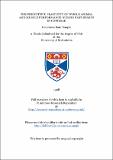Files in this item
The phenotypic plasticity of whole animal and muscle performance during fast-starts in Cottidae
Item metadata
| dc.contributor.advisor | Johnston, Ian A. | |
| dc.contributor.author | Temple, Genevieve Kate | |
| dc.coverage.spatial | 202 p. | en_US |
| dc.date.accessioned | 2018-07-04T16:04:32Z | |
| dc.date.available | 2018-07-04T16:04:32Z | |
| dc.date.issued | 1998 | |
| dc.identifier.uri | https://hdl.handle.net/10023/14938 | |
| dc.description.abstract | Chapter 1. Fast-starts are used by most fish species in order to capture prey and escape predators. An introduction to this mode of fish locomotion and the structure and function of the muscle powering swimming movements, is given. Temperature has the potential to alter fast-start behaviour at various levels of organisation ranging from the whole animal to the molecular and can act over time scales extending from the immediate to the evolutionary. The thermal dependence of fast-start performance is discussed. Chapter 2. The effects of acclimation and acute temperature on the kinematics of the escape response in two species of maidne Cottidae, the short-horn sculpin (Myoxocephalus scorpius L.) and the long-spined sea scorpion (Taurulus bubalis Euphr.) were examined. Hypotheses were formulated based on relevant studies and the natural history of the fish to test the idea that seasonal temperature acclimation conferred a fitness advantage and to examine whether acclimation responses were constant through development. Chapter 3. The effect of seasonal thermal acclimation on the in vivo strain and power output of the fast muscle fibres during escape responses in the short- horn sculpin was examined. Chapter 4. The kinematics, in vivo muscle action, power output and energetics of escape and prey capture responses in the short-horn sculpin are discussed. Fast-starts were filmed using high speed video synchronised with sonomicrometry and EMG. The in vivo muscle strain and activation recordings were abstracted for use in work loop experiments. Changes in the metabolic substrates following work loops from the two different types of fast-starts were analysed using high performance liquid chromatography (HPLC). Chapter 5 The velocity of the wave of curvature passing down the fish and the power requirements during fast-start escape responses were calculated non-invasively. This was carried out on both cottid species acclimated to 5 and 15 ° and filmed using high speed cinematography at 0.8, 5.0, 15.0 and 20.0 °. The power requirements for the contralateral contraction were 20 W. kg-1 muscle in 5 °-acclimated fish escaping at 5 ° and 58 W. kg-1 muscle in 15 °-acclimated fish swimming at 15 °. Comparative values of power output measured from work loop experiments in Chapter 3 were 33 and 66 W.kg-1 respectively. | en_US |
| dc.language.iso | en | en_US |
| dc.publisher | University of St Andrews | |
| dc.subject.lcc | QL638.C8T3 | en |
| dc.subject.lcsh | Cottidae | en |
| dc.title | The phenotypic plasticity of whole animal and muscle performance during fast-starts in Cottidae | en_US |
| dc.type | Thesis | en_US |
| dc.type.qualificationlevel | Doctoral | en_US |
| dc.type.qualificationname | PhD Doctor of Philosophy | en_US |
| dc.publisher.institution | The University of St Andrews | en_US |
This item appears in the following Collection(s)
Items in the St Andrews Research Repository are protected by copyright, with all rights reserved, unless otherwise indicated.

